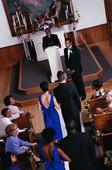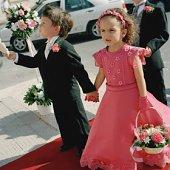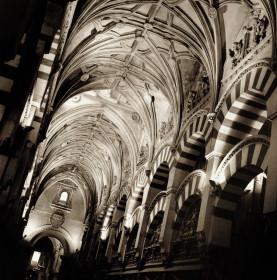Wedding Processional
This is the traditional wedding order of service-- from the arrangement of the wedding processional (bridesmaids, groomsmen, flowergirl, ringbearer, etc.) to the announcement of man and wife. This first page covers in what order your bridal party should walk.
Different types of wedding processionals
The order of wedding processionals follows a general pattern, but varies according to religious traditions. For example, here is a Traditional (Catholic/ Episcopal)wedding processional:
- The priest, groom, and best man enter through a side door and wait at the altar.
- The groomsmen and bridesmaids walk down in pairs, starting with the two who will stand farthest from the bride and groom, and ending with the best man and maid of honor.
- The ring bearer and/or flower girl.
- The bride and her father, or other close family member. The bride walks on the left side. If the bride's escort is her father, he leads her to the front of the aisle, then takes his seat next to the bride's mother.
Protestant wedding:
- The mothers of the bride and groom are seated after all guests are seated, and immediately before the start of the processional music. They are usually escorted to their seats by a brother of the bride or groom, or by another usher.
- After they are seated, the officiant, groom and best man enter by a side door and wait at the altar.
- Groomsmen may also enter by a side door, or can escort the bridesmaids.
- Bridesmaids
- Ring bearer and/or flower girl
- Maid or Matron of Honor
- The bride, escorted by her father or other close male family member or friend. At the front of the aisle, her escort can remain standing with her until the minister asks "Who gives this woman in marriage?" to which he responds "I do," or "Her mother and I do." However, some people feel this tradition is old fashioned and sexist, and choose to forgo it. In such a case, her escort walks with the bride to the front of the aisle, and then takes his seat in the front row.
Non-denominational ceremony, a secular ceremony, or a non-traditional ceremony
You can either borrow liberally from one of these traditions, or make up your own rules.
In all cases, the bride traditionally stands on the left, and the groom on the right. This dates back to medieval times when the groom might need to defend his bride in the middle of the ceremony, and wanted to leave his right hand, his sword hand, free. While few grooms even carry a sword anymore, the tradition has lasted.
A wedding processional using two aisles
People tackle the problem of two aisles in a variety of ways. You can choose to only use one aisle, but this means that many of your guests will feel far from the action. I often advise couples to do the processional up one aisle, and the recessional down the other. Another alternative is to have bridesmaids walk up one aisle, and groomsmen up the other. The bride and groom can then each choose an aisle to enter through.
A wedding processional with a small bridal party
If you only have a few people in your bridal party, it's a good idea to send them up one by one. For example, if you had a best man, maid of honor, flower girl, and ring bearer this should be the order:
- Groom takes his place at the front
- Best man enters
- Maid of Honor walks up aisle
- Ring Bearer
- Flower Girl
- Bride, with escort if she has one.
With such a small wedding party, it's probably not formal enough to warrant a formal seating of the mothers and grandmothers. However, if you still want to do this, let the best man seat the grandmothers and the groom seat the mothers as part of their entrances.
Order Of Service
The key elements utilized in most Western wedding ceremonies, in their most common order, are:
1) Introduction, Opening, or Invocation -- in which the officiant typically announces the purpose of the gathering, indicates the names of the bride and groom, welcomes the guests and solicits them to participate in the ceremony by their presence and, perhaps, their prayers.
2) Main Body -- in which the officiant ruminates on the meaning of marriage and the significance of the bride and groom's decision to join togetherin wedlock. The officiant may also share more casual remarks about the bride and groom as he or she has come to know them, and about the fitness of their union. This portion of the ceremony might also include religious or other readings by the officiant or by other persons who have been asked by the bride and groom to speak.
The Main Body is sometimes divided into the Interrogation and the Presentation (either may come first). The Interrogation specifically refers to the officiant asking the couple if they come of their own free will to marry; it may also include the officiant asking the potentially show stopping question, "If anyone has just cause why these two may not wed, speak now, or forever hold your peace." (With any luck your ceremony will be peaceful.) The Presentation is when the bride, or the bride and groom, are presented for marriage by their parent or parents (the familiar,"Who gives this woman").
3) Introduction to the Vows -- in which the officiant explains the significance of the vows which the couple are going to exchange.
4) Vows -- in which the bride and groom individually affirm their commitment to one another, in response to questions posed by the officiant; the responses usually take the form of "I do" or "I will." In the Western Christian tradition, this is the point at which they are officially married.
5) Exchange of Rings -- in which the couple, usually repeating phrases at the officiant's direction, declare their commitment to one another and place a wedding ring on the hand of their betrothed. In the Western Jewish tradition, this is the point at which they are officially married. See
.
6) Closing/Announcement of the Couple -- in which the officiant announces that the couple is officially wed. This may also include a final prayer or benediction, the officiant indicating that the groom may "kiss the bride," and/or the officiant "introducing" the newly married couple to the guests.
This ceremonial order is usually preceded by a processional, in which the wedding party members enter the ceremonial location, and is followed by a recessional, in which they exit.




